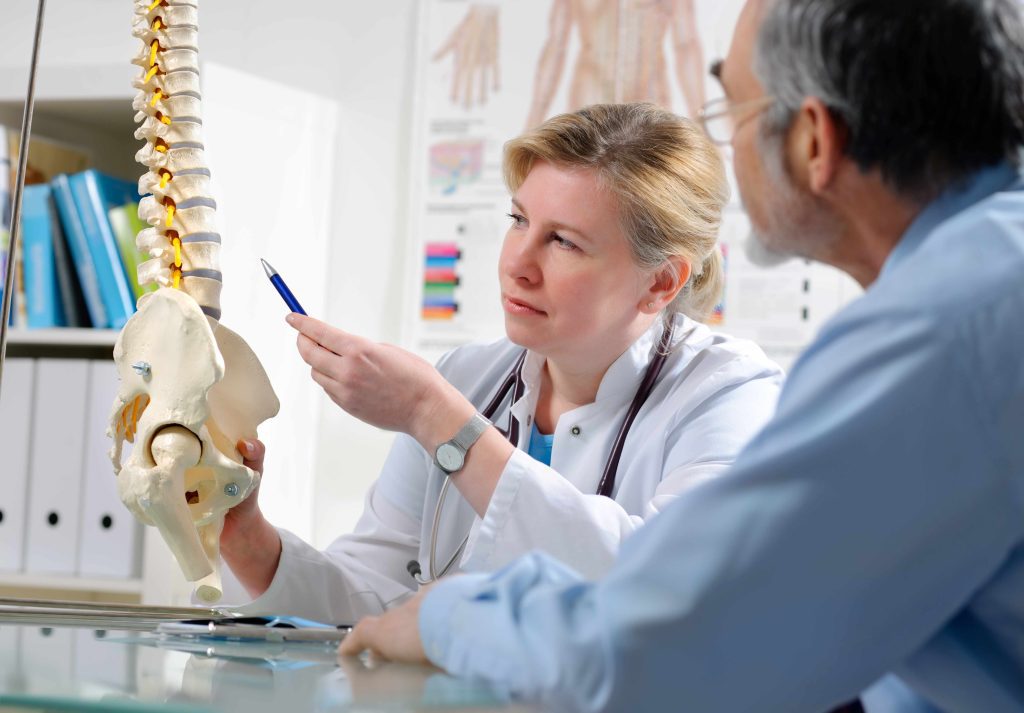If you are injured in an automobile accident you may be prescribed therapy or chiropractic therapy for car accidents in Texas. Often injuries from a car accident will cause immediate symptoms. However, some are subtle and will result in pain days, weeks or sometimes even months later. If you have had an accident in the past, you probably already know how bad this pain can get. As experienced car accident lawyers, we can tell you that masking the pain with painkillers is never enough. One of the best ways to definitively deal with this pain is through chiropractic therapy.
But what is chiropractic therapy? What kind of pain can chiropractic therapy control? Here are the answers to all the questions you might have if you are considering chiropractic therapy, including what to expect.

What is Chiropractic Therapy?
Chiropractic therapy involves the diagnosis and treatment of neuromuscular disorders through manual manipulation or adjustment of the spine. It is one of the commonest types of alternative medicine or complementary medicine.
The therapy is performed by a chiropractor who is a healthcare professional trained to restore the spine’s structural integrity, which reduces pressure on sensitive neurological tissue. Reduction in the pressure alleviates the irritation on the nerves that is likely causing you the pain. Additionally, it also reestablishes altered reflexes.
A chiropractor will also educate you on what you can do to help reduce your pain, including exercises, ergonomics and other therapies.
Goals of chiropractic therapy include:
- Reduction of pain
- Improvement of functionality
It may come as a surprise, but chiropractors treat a wide variety of conditions. Their practice is not limited to car accident injuries, as you may have thought. Some of the other conditions that chiropractic therapy is effective in the management include:
- Lower back pain
- Sciatica
- Neck pain
- Repetitive strains
- Sports injuries
- Headaches
You will need to realize that chiropractors don’t always work in isolation. They may co-manage you with other healthcare specialists. A chiropractor may refer you to a surgeon or physician if your condition is too severe and will most likely not improve with chiropractic therapy.
Types of Pain Treated Using Chiropractic Therapy
Car accidents can leave you with pain that is challenging to manage. Chiropractic therapy is an excellent option if you are looking for a natural, safe and holistic approach to controlling the pain. It effectively corrects the underlying injuries resulting in pain alleviation. You can opt for this option in case you have any of the following symptoms after a car accident in Texas:
- Whiplash and neck pain
- Lower back pain
- Shoulder and upper back pain
- Headaches and dizziness
- Hip, leg, knee and foot pain
Whiplash and Neck Pain from an accident
One of the commonest injuries from a car accident is whiplash. It results when your neck moves rapidly back and forth during a car accident, resulting in stretching and straining your neck muscles. While the stretching of the neck muscles is designed to absorb the pressure when your head is jolted, excessive stretching results in injury. It is the leading cause of neck pain after an auto accident.
Besides whiplash, the neck pain could be due to injury to your cervical spine, ligaments and other soft tissues.
Typically, your doctor will prescribe pain medications and anti-inflammatory drugs for the pain. However, these medications often don’t adequately control the pain. You may find it a bit difficult to move your head. The symptoms usually set in several days or weeks later.
An effective way to deal with whiplash and neck pain is to enlist the services of a chiropractor. After a careful examination and investigation of your injuries, the chiropractor will manually manipulate your neck muscles and cervical spine to reduce the pain.
Lower Back Pain
Experiencing lower back pain after a car accident means you sustained lower back injuries that require attention. These injuries are highly dependent on the angle at which the car was hit. Injuries that result in lower back pain include:
Muscle Strain
Straining the muscles in the lower back region and soreness is one of the most typical causes of lower back pain. It occurs in severe accidents and may be accompanied by pain in the neck, upper back and middle back.
Herniated Disc
Vertebral disc herniation results when the force during the accident is excessive, resulting in compression and subsequent deformation of the spongy cushioning between vertebral bones in your back. A herniated disc pinches on nerves passing nearby, which results in irritation and subsequently pain.
Nerve Injury
Neuropathic pain or pain due to injury to nerves is another cause of lower back pain. In fact, 20- 35% of patients with back pain have a neuropathic pain component, according to the US National Library of Medicine of the National Institute of Health. When you see a chiropractor, they may try to establish whether nerve injury is involved by inquiring about the following symptoms:
- Pain in the legs in case of sciatic nerve injury
- Weakness in the legs
- Tingling or burning sensations or even numbness
- Loss of bladder and bowel control
- A decline in sexual function
Vertebral Bone Fractures
Fractures of the vertebral bones can also result in pinching of the nerves and subsequent development of pain. While some fractures are minor, some may be big enough to result in compromise to your spinal cord. Therefore, seeking care is of utmost importance to avoid worsening of symptoms or compromise to your spine that may cause paralysis.
Other Soft Tissue Injuries
A car accident can also cause injuries to other soft tissues in your lower back, for instance, the ligaments and tendons. Such injuries manifest as lower back pain.
Chiropractic therapy can help combat your lower back pain. Once a chiropractor establishes the most likely cause of your pain, they will carry out therapy sessions to help you get better. If the injuries are severe, for example, serious vertebral fractures that may result in injury to your spinal cord, you will be referred to a neurosurgeon for management.
Shoulder and Upper Back Pain
Pain in your shoulder and upper back can make it very challenging to carry out your daily activities. It usually points towards an injury in that region that needs attention. Some of the common injuries that result in shoulder and upper back pain include:
- Shoulder dislocation
- Muscle strain
- Disc herniation
- Ligament strain
- Broken shoulder blade
- Broken collarbone
- Rotator cuff injuries
- Whiplash
While some of these injuries will result in immediate and severe pain that will require hospitalization and emergency treatment, some may not be apparent until days later. It may even take weeks or months for the pain to develop in some instances.
There are many trained chiropractors in Texas to help you on your road to recovery. Once severe injuries that may require surgery have been ruled out, the other injuries can be managed through chiropractic therapy.
Headaches and Dizziness
Perhaps one of the most worrying symptoms after a car accident is a headache. That is because you will think it’s most likely due to a head injury, which can be pretty serious. You will therefore end up not only having to bear with the headaches but also mental and emotional anguish. However, it is not always due to traumatic brain injury, as you may be thinking.
Actually, 50% of people hospitalized after a car accident continue experiencing headaches and dizziness, according to National Highway Traffic Safety Administration. A year later, up to 33% of the patients will still have headaches.
It’s, therefore, not always a head injury that is the reason for the headaches and dizziness. Whiplash is one of the causes of these headaches. Injuries to soft tissues in your neck and upper back can exert undue pressure to your head, resulting in headaches.
Luckily, you don’t have to struggle with the pain anymore. Chiropractic therapy can help address the injuries to the soft tissues in your neck and upper back that may be causing the headaches.
Hip, Leg, Knee and Foot Pain
Pain in your hip, leg, knee or foot can be severely limiting to your daily activities. It is often due to direct injury to the bones, which may even be broken or crushed. However, the pain may be due to injuries in your lumbar spine, nerves from the spine or soft tissues in the affected area.
Injuries in your lumbar spine may be manifested as pain in your hip, leg, or even foot. These injuries include vertebral bone fractures, disc herniation and spinal canal narrowing. Such injuries interfere with the nerve roots that transport sensation impulses from the legs to the brain. Consequently, there is an irritation that you will feel as pain in your hip, leg, knee or foot. Soft tissues like muscles, tendons and ligaments can be injured, which results in soreness.
If the injuries are due to crushed or broken bones, your best option is to get the help of an orthopedic surgeon. If such causes are ruled out, your best bet will be manual manipulation by a chiropractor.
What to Expect During Chiropractic Therapy
Although you feel ready to get the help of a chiropractor in Texas, you may still have several questions. What happens when you go to see a chiropractor? Do chiropractors examine you physically? Will imaging and lab investigations be ordered?
You don’t have to wonder anymore. Here are the answers to your questions.
Process of Chiropractic Care
A chiropractor is like any other healthcare professional. Although the setup might be a little different, you will go through steps similar to those you experience in a hospital. Here is what happens when you go to see a chiropractor in Texas or anywhere else.
Consultation
The initial step is consultation. During this step, you meet the chiropractor and hold a brief discussion about why you need help. You will provide a brief account of what you are suffering from, for instance:
- How long the symptoms have lasted
- Description of symptoms, for example, burning, tingling or throbbing
- Location of the pain
- What alleviates the pain, for instance sitting, or lying down
- What worsens the pain like standing
A chiropractor establishes whether you will benefit from chiropractic therapy during this consultation. Once they establish that you are a prime candidate, you will proceed to the next step.
Case History
Your chiropractor will take a thorough history during the case history step. It could be on the same day or a different day, depending on when you are scheduled on their list. The specialist will dive into more detail to establish what exactly could be causing the pain. At this point, they will also rule out other possible causes of the pain you are presenting with, for instance, a cause other than the accident.
Other aspects of the history include family history, dietary habits, past history of other treatments, occupational history, psychosocial history and other aspects. The chiropractor aims to understand you better to tailor your therapy to your needs and special characteristics.
Physical Examination
After taking the complete history, a chiropractor will physically examine you. The focus of the examination will be on the affected area. They may use static and motion palpation techniques to determine the restricted region.
Chiropractors are trained in examining the joints, bones, muscles and tendons of your head, spine, extremities and other parts. They aim to establish any misalignment, asymmetry, tenderness, defects, and other issues during the examination.
Assessments that these specialists perform include:
- General examinations- orthopedic, cardiovascular and other examinations
- Neurological tests- nerve root compression/ tension, coordination, motor strength and reflexes
- Specialized assessment- range of motion, muscle strength, stability, and muscle tone
Investigations
Most of the time, the chiropractor establishes the injury causing your symptoms by the time they finish the physical examination. However, they may order imaging tests or laboratory investigations in case their findings are inconclusive.
X-rays are the primary imaging tests that chiropractors order and interpret. However, they may need MRI or CT scans that show better detail, especially for injuries in your neck, back and other areas. Although a radiologist is specially trained in reading images and making a diagnosis from the MRI or CT scans it is often an experienced Chiropractor who explains what’s wrong with you in layman’s terms. You may be asked to provide the imaging diagnostic tests you had done after the car accident when visiting the hospital.

Laboratory investigations can help show the severity of your condition. A chiropractor can also rely on these findings to decide whether you will need to see a physician.
Chiropractic Therapy
Once the chiropractor settles on a diagnosis, they will schedule your therapy. You may need several sessions to treat your pain completely. You don’t have to worry about the therapy as it is like any other procedure in a hospital. Additionally, it is non-invasive.
Conclusion
You don’t have to keep suffering from pain and other symptoms after a car accident. Chiropractic therapy is one of the best ways to manage pain safely, naturally and holistically. It can help you avoid chronically using painkillers or undergoing risky surgeries. There are many professional chiropractors in Texas ready to help you overcome the pain.
CALL TODAY FOR A FREE CONSULTATION WITH OUR CAR ACCIDENT ATTORNEY 713-572-6446
This page is for informational purposes provided by the personal injury law firm of Jerome O. Fjeld, PLLC has served injury victims in Texas for nearly two decades. Our firm’s primary office is in Houston, TX with offices in Austin and Victoria. Our firm’s focus is personal injury and we help victims when someone is injured by the negligence or carelessness of another in the following types of cases:
- dog bites and dog attacks,
- trucking accidents,
- car accidents,
- construction accidents,
- uber accidents,
- boating accidents,
- work accidents,
- slip and falls,
- bike accidents,
- accidente de carro and
- other cases when someone is seriously injured by the negligence or carelessness of another.
